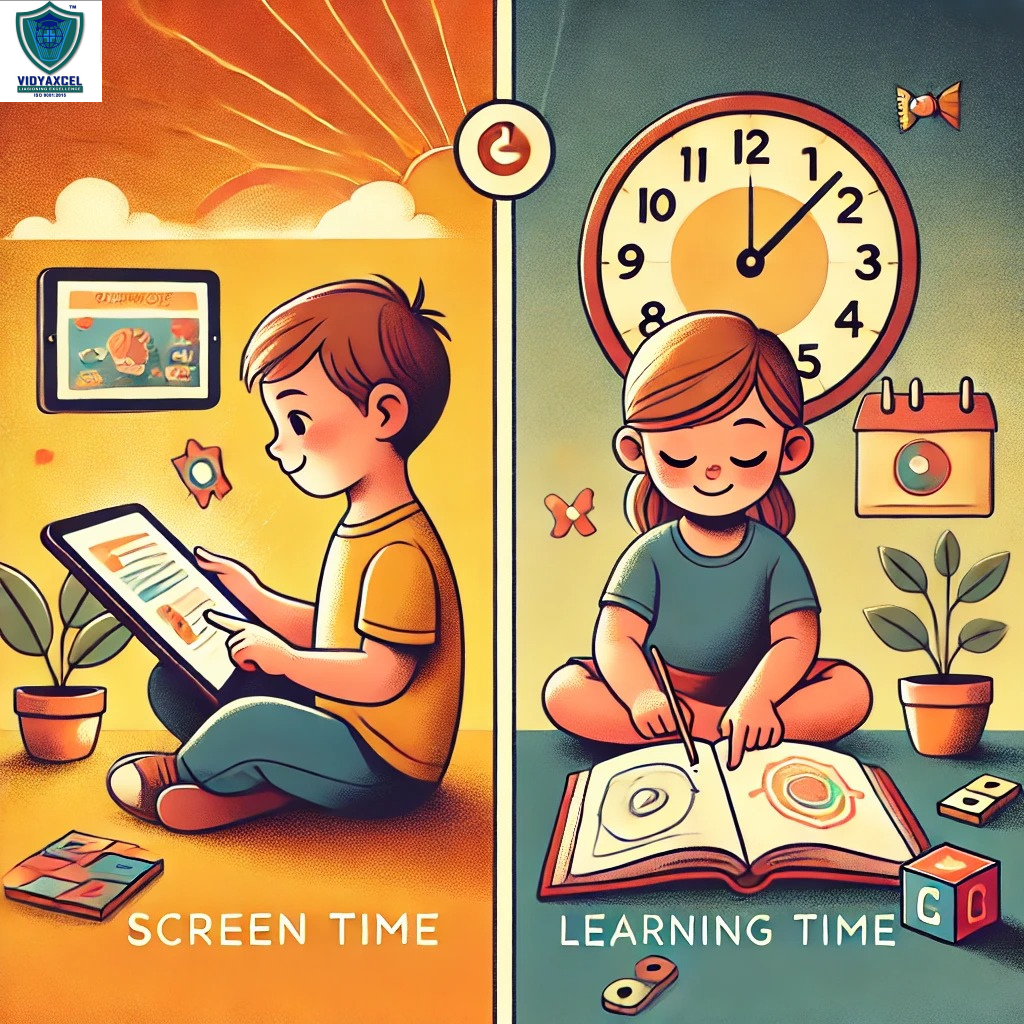Blog Details

28Feb
Screen Time vs. Learning Time: How Parents Can Maintain the Balance
In today's digital world, screens have become an inevitable part of children's lives. Whether it's for education, entertainment, or social interaction, children are spending more time on smartphones, tablets, and computers than ever before. While technology plays a vital role in learning and development, excessive screen time can impact children's physical health, social skills, and overall well-being. Maintaining a balance between screen time and learning time is essential for raising well-rounded, healthy, and independent children.
Why Is It Important to Balance Screen Time and Learning Time?
Too much screen time can:
- Lead to eye strain and poor posture
- Affect sleep patterns
- Increase anxiety and irritability
- Reduce physical activity
- Limit social interaction
On the other hand, the right amount of educational screen time can boost learning, creativity, and cognitive skills.
The challenge for parents is to create a balance where screen time becomes a tool for learning rather than just entertainment.
How Parents Can Maintain the Balance
1. Set Clear Screen Time Rules
✅ How to Do It:
- Decide the daily screen time limit based on your child's age.
- Communicate the rules clearly and involve your child in setting boundaries.
- Use the 20-20-20 rule (20 minutes screen time, 20 seconds break, look 20 feet away) to protect their eyes.
2. Prioritize Educational Content
Not all screen time is harmful — some can enhance learning.
✅ How to Do It:
- Choose educational apps, games, and videos like Duolingo, Khan Academy Kids, and Google Read Along.
- Set a ratio like 70% educational, 30% entertainment.
- Encourage watching documentaries or interactive learning platforms.
3. Create a Screen Time Schedule
A routine helps children understand when screens are for learning and when they're for fun.
✅ How to Do It:
|
Activity |
Suggested Time |
|
Online Classes |
1-2 hours/day |
|
Educational Apps |
30 mins/day |
|
Entertainment |
30 mins/day |
|
Screen-Free Play |
2-3 hours/day |
4. Encourage Screen-Free Activities
Promoting offline hobbies helps children stay active and creative.
✅ How to Do It:
- Engage them in art, puzzles, sports, or reading books.
- Plan family game nights or outdoor activities.
- Introduce DIY craft projects or gardening.
5. Be a Role Model
Children imitate their parents' habits.
✅ How to Do It:
- Limit your own screen time during family hours.
- Spend time reading, exercising, or doing creative tasks together.
- Use technology for learning and productivity rather than just social media.
- 6. Use Parental Control Apps
- Technology can help you maintain screen limits.
- ✅ Recommended Apps:
|
App Name |
Purpose |
Age Group |
|
Google Family Link |
App time limits |
6+ |
|
Qustodio |
Screen time + website filters |
8+ |
|
OurPact |
App blocking |
10+ |
7. Set Screen-Free Zones
Designate certain areas in the house where screens are not allowed.
✅ How to Do It:
- No screens at the dining table.
- Screen-free bedrooms to improve sleep habits.
- Encourage family conversations during meals.
8. Balance Digital Learning with Physical Learning
For every hour of screen-based learning, encourage 30 minutes of hands-on activities.
✅ Examples:
- Math worksheets instead of digital apps
- Reading physical books instead of e-books
- Practicing writing instead of typing
9. Teach Self-Regulation
Help your child learn to manage their own screen time responsibly.
✅ How to Do It:
- Explain the importance of balancing screen time and physical activity.
- Use timers or alarms to track usage.
- Reward them for following the schedule independently.
10. Create Tech-Free Family Time
Spending quality time as a family without screens helps children understand that life exists beyond technology.
✅ How to Do It:
- Organize family walks, board games, or storytelling sessions.
- Have a "No Screen Sunday" tradition.
- Cook or garden together as a family activity.
📌 Ideal Screen Time Based on Age (According to WHO Guidelines)
|
Age Group |
Recommended Screen Time |
|
2-5 years |
Max 1 hour/day (supervised) |
|
6-12 years |
1-2 hours/day |
|
13-18 years |
2-3 hours/day |
Conclusion
Maintaining a healthy balance between screen time and learning time is key to raising well-rounded, confident children in the digital era. With thoughtful rules, active participation, and encouragement, parents can turn screen time into a positive learning tool rather than a distraction. The goal is not to eliminate technology but to teach children how to use it responsibly while giving equal importance to physical activities, family bonding, and personal growth. By creating a supportive environment, parents can help their children embrace both technology and real-world experiences in a balanced and meaningful way.
FAQ’s
Why is it important to balance screen time and learning time?
Balancing screen time and learning time helps children enjoy the benefits of technology without developing unhealthy habits. It promotes better physical health, social interaction, emotional well-being, and cognitive growth while preventing issues like screen addiction and lack of physical activity.
How can I balance screen time during holidays or weekends?
- Create a holiday schedule with equal time for screen activities, outdoor play, and family bonding.
- Allow a little extra screen time but balance it with creative projects or outdoor games.
- Use tech-free weekends or "No Screen Sunday" traditions.
What if my child argues or refuses to limit screen time?
- Stay calm and consistent with your rules.
- Offer alternative activities that interest your child.
- Gradually reduce screen time instead of sudden restrictions.
- Use a reward system for following screen rules.
How can I help my child become responsible with screen time?
- Involve them in setting their own screen time rules.
- Use timers or alarms to remind them when their screen time is up.
- Explain why balancing screen time is important.
- Praise them for sticking to the schedule.
How can I introduce screen-free time without making it feel like a punishment?
- Plan fun screen-free activities like outdoor games, art, or family board games.
- Create a tech-free zone like the dining room or bedroom.
- Set specific "No Screen Hours" during the day for family bonding.
- Join your child in screen-free activities to lead by example.
Our Office: West Bengal, Maharashtra & Delhi.
For More Infomation about admission in Medical, Engineering, Management & Study in Overseas Details.
View Current Study Overseas, Medical, Engineering & Management Admission Details Video.





